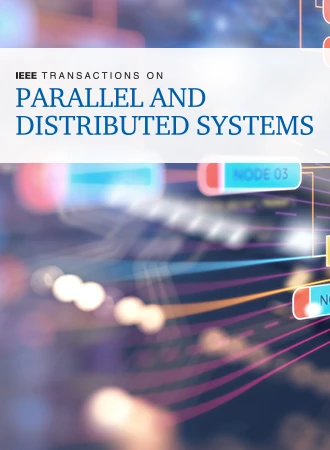Parallel Greedy Algorithms for Steiner Forest
IF 5.6
2区 计算机科学
Q1 COMPUTER SCIENCE, THEORY & METHODS
IEEE Transactions on Parallel and Distributed Systems
Pub Date : 2025-04-24
DOI:10.1109/TPDS.2025.3563849
引用次数: 0
Abstract
The Steiner Forest Problem is a fundamental combinatorial optimization problem in operations research and computer science. Given an undirected graph with non-negative weights for edges and a set of pairs of vertices called terminals, the Steiner Forest Problem is to find the minimum cost subgraph that connects each of the terminal pairs together. We design a family of parallel greedy algorithms based on a sequential heuristic greedy algorithm called Paired Greedy, which iteratively connects the terminal pairs that have the minimum distance. The family of parallel algorithms consists of a set of algorithms exhibiting various degrees of parallelism determined by the number of pairs that are connected in parallel in each iteration of the algorithms. We implement and run the algorithms on a multi-core system and perform an extensive experimental analysis. We analyzed the performance of the algorithms on a rich library of Steiner Forest instances with various underlying graph types. The results show that our proposed parallel algorithms achieve significant speedup with respect to the sequential Paired Greedy algorithm and provide solutions with costs that are very close to those of the solutions obtained by the sequential Paired Greedy algorithm. We provide recommendation on selecting the type of parallel algorithm and its parameters in order to achieve the most efficient results for each class of instances.Steiner森林的并行贪心算法
斯坦纳森林问题是运筹学和计算机科学中的一个基本组合优化问题。给定一个边权为非负的无向图和一组称为端点的顶点对,斯坦纳森林问题是找到将每个端点对连接在一起的最小代价子图。在顺序启发式贪心算法的基础上,设计了一组并行贪心算法,称为配对贪心算法,迭代连接距离最小的终端对。并行算法族由一组算法组成,这些算法表现出不同程度的并行性,这些并行性由算法每次迭代中并行连接的对的数量决定。我们在多核系统上实现和运行算法,并进行了广泛的实验分析。我们分析了算法在具有各种底层图类型的丰富Steiner Forest实例库上的性能。结果表明,我们提出的并行算法相对于序列配对贪婪算法获得了显著的加速,并且提供的解的代价与序列配对贪婪算法得到的解的代价非常接近。我们提供了选择并行算法类型及其参数的建议,以便在每一类实例中获得最有效的结果。
本文章由计算机程序翻译,如有差异,请以英文原文为准。
求助全文
约1分钟内获得全文
求助全文
来源期刊

IEEE Transactions on Parallel and Distributed Systems
工程技术-工程:电子与电气
CiteScore
11.00
自引率
9.40%
发文量
281
审稿时长
5.6 months
期刊介绍:
IEEE Transactions on Parallel and Distributed Systems (TPDS) is published monthly. It publishes a range of papers, comments on previously published papers, and survey articles that deal with the parallel and distributed systems research areas of current importance to our readers. Particular areas of interest include, but are not limited to:
a) Parallel and distributed algorithms, focusing on topics such as: models of computation; numerical, combinatorial, and data-intensive parallel algorithms, scalability of algorithms and data structures for parallel and distributed systems, communication and synchronization protocols, network algorithms, scheduling, and load balancing.
b) Applications of parallel and distributed computing, including computational and data-enabled science and engineering, big data applications, parallel crowd sourcing, large-scale social network analysis, management of big data, cloud and grid computing, scientific and biomedical applications, mobile computing, and cyber-physical systems.
c) Parallel and distributed architectures, including architectures for instruction-level and thread-level parallelism; design, analysis, implementation, fault resilience and performance measurements of multiple-processor systems; multicore processors, heterogeneous many-core systems; petascale and exascale systems designs; novel big data architectures; special purpose architectures, including graphics processors, signal processors, network processors, media accelerators, and other special purpose processors and accelerators; impact of technology on architecture; network and interconnect architectures; parallel I/O and storage systems; architecture of the memory hierarchy; power-efficient and green computing architectures; dependable architectures; and performance modeling and evaluation.
d) Parallel and distributed software, including parallel and multicore programming languages and compilers, runtime systems, operating systems, Internet computing and web services, resource management including green computing, middleware for grids, clouds, and data centers, libraries, performance modeling and evaluation, parallel programming paradigms, and programming environments and tools.
 求助内容:
求助内容: 应助结果提醒方式:
应助结果提醒方式:


